Related Research Articles

David was, according to the Hebrew Bible, the third king of the United Kingdom of Israel. In the Books of Samuel, he is described as a young shepherd and harpist who gains fame by slaying Goliath, a champion of the Philistines, in southern Canaan. David becomes a favourite of Saul, the first king of Israel; he also forges a notably close friendship with Jonathan, a son of Saul. However, under the paranoia that David is seeking to usurp the throne, Saul attempts to kill David, forcing the latter to go into hiding and effectively operate as a fugitive for several years. After Saul and Jonathan are both killed in battle against the Philistines, a 30-year-old David is anointed king over all of Israel and Judah. Following his rise to power, David conquers the city of Jerusalem and establishes it as Israel's capital, subsequently taking the Ark of the Covenant into the city to be the central point of worship in the Israelite religion.

The Kingdom of Judah was an Israelite kingdom of the Southern Levant during the Iron Age. Centered in Judea, the kingdom's capital was Jerusalem. The other Israelite polity, the Kingdom of Israel, lay to the north. Jews are named after Judah and are primarily descended from it.
Ziklag is the biblical name of a town that was located in the Negev region in the south-west of what was the Kingdom of Judah. It was a provincial town within the Philistine kingdom of Gath when Achish was king. Its exact location has not been identified with any certainty.
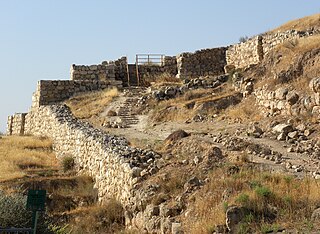
Lachish was an ancient Canaanite and Israelite city in the Shephelah region of Israel, on the South bank of the Lakhish River, mentioned several times in the Hebrew Bible. The current tell (ruin) by that name, known as Tel Lachish or Tell ed-Duweir ,, has been identified with the biblical Lachish. Today, it is an Israeli national park operated and maintained by the Israel Nature and Parks Authority. The park was established on lands of the depopulated Palestinian village of Qobebet Ibn ‘Awwad which was north of the Tel. It lies near the present-day moshav of Lakhish.

Ish-bosheth, also called Eshbaal was, according to the Hebrew Bible, the second monarch of the Kingdom of Israel who succeeded his father, Saul. He reigned for two years, during which he was at war with David. He was killed by two of his own army captains.
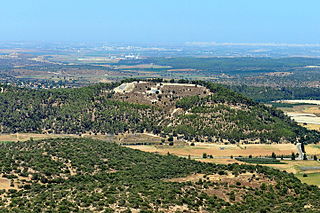
Azekah was an ancient town in the Shfela guarding the upper reaches of the Valley of Elah, about 26 km (16 mi) northwest of Hebron.

The Valley of Elah or Ella Valley, called in Arabic: وادي السنط, Wadi es-Sunt, is a long, shallow valley in Israel and the West Bank best known as the place described in the Hebrew Bible where the Israelites were encamped when David fought Goliath. It is home to several important archaeological sites, including those identified as the ancient towns of Azekah and Socho. Rising up from the valley on its extreme southeast end lies the hilltop ruin Adullam, and on its north lie the ruins of the ancient fortress city of Khirbet Qeiyafa, which is identified with the ancient town of Sha'araim.
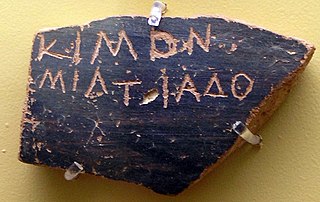
An ostracon is a piece of pottery, usually broken off from a vase or other earthenware vessel. In an archaeological or epigraphical context, ostraca refer to sherds or even small pieces of stone that have writing scratched into them. Usually these are considered to have been broken off before the writing was added; ancient people used the cheap, plentiful and durable broken pieces of pottery around them as convenient places to place writing for a wide variety of purposes, mostly very short inscriptions, but in some cases very long.

The United Monarchy in the Hebrew Bible refers to Israel and Judah under the reigns of Saul, David, and Solomon. It is traditionally dated to have lasted between c. 1047 BCE and c. 930 BCE. According to the biblical account, on the succession of Solomon's son Rehoboam, the United Monarchy would have split into two separate kingdoms: the Kingdom of Israel in the north, containing the cities of Shechem and Samaria; and the Kingdom of Judah in the south, containing the city of Jerusalem and the Jewish Temple. However, whether or not the United Monarchy actually existed is a matter of ongoing academic debate.
Gershon Galil is Professor of Biblical Studies and Ancient History and former chair of the Department of Jewish History at the University of Haifa, Mount Carmel, Haifa, Israel.
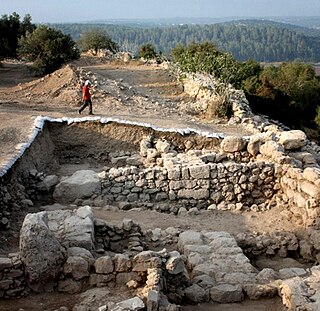
Khirbet Qeiyafa, also known as Elah Fortress and in Hebrew as Horbat Qayafa, is the site of an ancient fortress city overlooking the Elah Valley and dated to the first half of the 10th century BCE. The ruins of the fortress were uncovered in 2007, near the Israeli city of Beit Shemesh, 30 km (20 mi) from Jerusalem. It covers nearly 2.5 ha and is encircled by a 700-meter-long (2,300 ft) city wall constructed of stones weighing up to eight tons each. Excavations at site continued in subsequent years. A number of archaeologists, mainly the two excavators, Yosef Garfinkel and Saar Ganor, have claimed that it might be one of two biblical cities, either Sha'arayim, whose name they interpret as "Two Gates", because of the two gates discovered on the site, or Neta'im; and that the large structure at the center is an administrative building dating to the reign of King David, where he might have lodged at some point. This is based on their conclusions that the site dates to the early Iron IIA, ca. 1025–975 BCE, a range which includes the biblical date for the biblical Kingdom of David. Others suggest it might represent either a North Israelite, Philistine, or Canaanite fortress, a claim rejected by the archaeological team that excavated the site. The team's conclusion that Khirbet Qeiyafa was a fortress of King David has been criticised by some scholars.

Yosef Garfinkel is an Israeli archaeologist and academic. He is Professor of Prehistoric Archaeology and of Archaeology of the Biblical Period at the Hebrew University of Jerusalem.

Khirbat Umm Burj was a Palestinian Arab village in the Hebron Subdistrict, sometimes designated in modern maps as Burgin. Its ruins are today located within the borders of Israel. It occupied an extensive site, stretching about 30 dunams on the crest of a hill, rising some 430 metres (1,410 ft) above sea level, and commanding a good prospect of the surrounding region. It was depopulated during the 1948 Arab–Israeli War on October 28, 1948, during the third stage of Operation Yo'av under the command of Yigal Allon. The site is located 17 km northwest of Hebron.

Shaaraim, possibly meaning "Two Gates", is an Israelite city mentioned several times in the Hebrew Bible and the Old Testament. It has been identified by some with Khirbet Qeiyafa, an archaeological site on a hilltop overlooking the Elah Valley in the Judean hills.
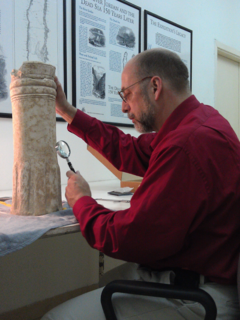
Prof. Christopher A. Rollston is a scholar of the ancient Near East, specializing in Hebrew Bible, Greek New Testament, Old Testament Apocrypha, Northwest Semitic literature, epigraphy and paleography.

According to the First Book of Kings and the Second Book of Chronicles of the Hebrew Bible, Jeroboam's Revolt was an armed insurrection against Rehoboam, king of the United Monarchy of Israel, and subsequently the Kingdom of Judah, led by Jeroboam in the late 10th century BCE. The conflict, referring to the independence of the Kingdom of Samaria and the subsequent civil war during Jeroboam's rule, is said to have begun shortly after the death of Solomon lasting until the Battle of Mount Zemaraim. The conflict began due to discontent under the rule of Solomon's successor, his son Rehoboam, and was waged with the goal of breaking away from the United Monarchy of Israel. Though this goal was achieved very early on in the conflict, the war continued throughout the duration of Rehoboam's reign and well into the reign of his son, Abijam, who defeated the armies of Jeroboam but failed to reunite the kingdoms.

Lavnin (Hebrew: חורבת לבנין)(Arabic: خربة تل البيضة), is a late Bronze Age archaeological site situated in Israel's Adullam region, rising some 389 metres (1,276 ft) above sea level. The site lies 8 kilometres (5.0 mi) northwest of Beit Gubrin, and about 1 kilometer west-north-west of Khirbat Umm Burj, directly south of Nehusha.

The Khirbet Qeiyafa ostracon is a 15-by-16.5-centimetre ostracon with five lines of text, discovered during excavations at Khirbet Qeiyafa in 2008. Hebrew University archaeologist Amihai Mazar said the inscription was the longest Proto-Canaanite text ever found. Carbon-14 dating of olive pips found in the same context with the ostracon and pottery analysis offer a date c. 3,000 years ago.

Khirbet er-Ra'i, also Khirbet al-Ra'i, is an archaeological site in the Shephelah region of Israel. It is located 4 km west of Lachish.
Nadav Na'aman is an Israeli archaeologist and historian. He specializes in the study of Near East in the second and first millenniums BC. His research combines the history of the Ancient Near East, archaeology, Assyrology, and the study of the Bible. He possesses broad knowledge in all these four branches of research.
References
- ↑ Bronner, Ethan - Find of Ancient City Could Alter Notions of Biblical David, New York Times, October 29, 2008
- ↑ The Associated Press - Have Israeli archaeologists found world's oldest Hebrew inscription? Haaretz.com, Oct. 30, 2008